
What would it be like to visit different planets, in different galaxies, and to interact with extraterrestrial life? How would the last humans on Earth survive in a post-apocalyptic world? What if we could go far into the past or the future, and even across dimensions?
Click start to play today’s Crossword, and identify some of the greatest science fiction writers of the 1960s.
Of all the genres, science fiction is probably the most successful at keeping us connected to our curiosity and our humanity. Even as authors create whole universes or dystopian realities in their novels, the stories often come back to human nature and the choices we are compelled to make in impossibly difficult situations.
Those choices play a huge role in a new sub-genre of science fiction that is taking hold of the literary world in a big way: climate fiction, or cli-fi. The term was coined by a Tokyo-based freelance writer named Dan Bloom in 2011, when he wrote about a novel called Polar City Red by Jim Laughter – the story revolves around climate refugees in Alaska, US, many years in the future.
According to British-Australian cultural theorist Andrew Milner, who co-authored the book Science Fiction and Climate Change: A Sociological Approach, climate fiction is set apart from regular science fiction in two areas: the climate change explored has to be caused by humans, and the fiction must be set on Earth.
Today, there are hundreds of cli-fi books in dozens of languages, according to the Smithsonian magazine, the official journal published by the Smithsonian Institution in Washington, US. In December 2020, Germany even hosted the world’s first climate fiction festival in Berlin. There’s a reason for the uptick in cli-fi novels – with a planet in the grip of a climate crisis, cli-fi is compelling readers to open their eyes to the reality of global warming, and the devastating effects it will have on Earth. But it does so in an immersive way, through storytelling that is very different from what once sees or reads in the news.
By plunging into worlds faced with climate change, readers are forced to think about the Earth’s future in a way they have never done before. They share the same terrors as refugees who are trying to survive in sinking mangrove islands (Amitav Ghosh’s Gun Island), or the same bafflement of a rural town responding to the unexpected arrival of thousands of fleeing monarch butterflies (Barbara Kingsolver’s Flight Behavior).
If art functions as a mirror to our reality, then cli-fi is the next logical step for the literary world.
Have you read any cli-fi novels? Play today’s Crossword and let us know at games@gulfnews.com.



